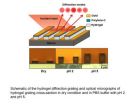(Press-News.org) VIDEO:
Tagging and tracking leatherback sea turtles has produced new insights into the turtles' behavior in a part of the South Pacific Ocean long considered an oceanic desert. The new data...
Click here for more information.
Leatherbacks. They are the Olympians of the turtle world – swimming farther, diving deeper and venturing into colder waters than any other marine turtle species. But for all their toughness, they have still suffered a 90 percent drop in their population in the eastern Pacific Ocean over the last 20-plus years, largely at the hands of humanity.
Now, new data from a 5-year-long project tagging and tracking the turtles are providing insights into their behavior, explaining why they congregate for months in what appeared to be one of the most nutrient-poor regions in the oceans, the South Pacific Gyre, and also helping researchers predict their movements on the high seas.
This new view of the lives of leatherbacks could offer a way to keep the turtles out of harm's way and give their numbers a chance to rebound.
"By taking the data we've gathered on their movements and integrating it with data on the surrounding oceanographic conditions, we've been able to identify what kind of habitats the leatherbacks prefer. This information is helping us develop models to predict where they might go and when they might show up there," said Stanford biologist George Shillinger, lead author of a paper to be published in Marine Ecology Progress Series and available online.
Until now, researchers didn't know why the leatherbacks that nest at Playa Grande in Costa Rica headed for the gyre and lingered for months. Satellite surface data suggested that this area spanning the Pacific Ocean between South America and New Zealand, from the low to mid-latitudes, appeared to be a virtual desert in the ocean, largely devoid of nutrients.
However, the presence of substantial tuna and swordfish fisheries within the region suggested there must be ample forage of some sort available.
Because only limited data exist concerning the diversity, abundance and distribution of the leatherback's favorite prey – gelatinous zooplankton, such as jellyfish – within the South Pacific Gyre, no one knew whether the turtles had food down there or not.
"Nobody is really out chasing jellyfish down," Shillinger said. "They are poorly studied organisms and there is very little data on them in the region of the gyre."
But the data that came back from the tagged turtles suggest there may be plenty of jellyfish on which to feast.
"We saw a distinct reduction in the swimming speed of the turtles as they entered the South Pacific Gyre," Shillinger said. "They were making more turns, diving more frequently and diving deeper. All those things suggest feeding behavior."
Another piece of evidence was the timing of the turtles' dives. Like many marine organisms, jellyfish appear to engage in daily vertical migrations, moving into shallower depths at night and returning to somewhat deeper depths during the day.
The turtles' dives mirrored those movements, with their nighttime dives averaging about 38 meters deep, while average daytime dives were around 65 meters.
"The deepest dives we had in the data set were in the daytime, including the longest one, which was over 900 meters," Shillinger said. "That dive was also one of the longest leatherback dives ever reported. It was about 84 minutes." The cause for these superlative dives remains a mystery, although seeking prey and avoiding predators are likely motivations.
"Understanding what sort of areas leatherbacks are likely to favor is a critical first step in protecting them in the open ocean," he said.
From 2004 to 2007, Shillinger and his colleagues tagged 46 female leatherbacks on the beach in Costa Rica with satellite tags that broadcast information on location, depth and water temperature for an average of 245 days, with one tag transmitting for 562 days. "Altogether, it added up to 13,038 days of turtle tracking," Shillinger said.
One of the biggest hazards leatherbacks face on the high seas is longline fishing, a widely used approach for capturing commercially valuable species such as tuna and swordfish. The turtles also face fishing pressure from gill nets and longlines as they swim through coastal waters on their way out to the open ocean.
The problem, Shillinger said, is that areas that attract commercially desirable species also tend to be attractive to leatherbacks and other non-targeted species, known as by-catch.
"We are really going to have to link our research on turtles with a better understanding of where and how fishing is being done, things like how many hooks and nets are in the water and for how long," he said. "We also need to know more about the by-catch – which non-targeted species are being caught and in what numbers."
Having all that data would help Shillinger and his colleagues pinpoint the areas where fishing activity is most likely to coincide with turtle activity and determine what mitigation measures would be most effective.
Temporary closure of certain areas – breeding zones, migration routes and rich foraging habitats – when turtles are most likely to be concentrated there is one possible measure.
"We are not talking about closing the whole ocean. When the turtles have moved through, they can go back to fishing, in a lot of cases," Shillinger said.
Modification of fishing techniques, such as deploying hooks at the depths that are least likely to be occupied by turtles, could also help.
Shillinger emphasized that the timing of the turtles' presence, or the exact locations they inhabit, may well vary somewhat from year to year as ocean conditions vary, so mitigation measures will have to adapt to changing conditions.
"No one is out to kill turtles," Shillinger said. "We are looking for solutions that are less adversarial with fishermen and more productive for turtle conservation."
The information collected from turtles in the South Pacific Gyre is already helping Shillinger and his colleagues refine their modeling of the turtles' movements.
Overall, Shillinger said, the leatherbacks showed an affinity for areas with cooler sea surface temperatures and stronger upwellings of deep, cool, nutrient-rich water, which drives in an increased abundance of life, including prey.
Another striking piece of data involved some synchronized swimming on the part of the turtles, Shillinger said. When the turtles hit about 35 to 37 degrees latitude south of the equator, they would stop swimming south and fan out along a belt to the east and west.
"They would be strung out hundreds of miles apart along this boundary and then, in concert, swing northward, all at about the same time," Shillinger said. "They might be responding to some sort of cue that we're not aware of, we just don't know. At this point, it is a mystery."
Although the temperature of the sea surface water decreases closer to the south pole, the leatherbacks can readily tolerate the colder water, so the researchers speculate that changes in the distribution of gelatinous zooplankton may have influenced the turtles not to go farther south. Or the turtles might just prefer to avoid the cooler waters, as it takes less energy to stay warm. The southern thermal bound occurred where the sea surface water temperature was about 14 to 15 degrees Celsius (57 to 59 degrees Fahrenheit).
"This information will help us refine our predictions regarding what sort of conditions attract leatherbacks, which is a challenge in the continually changing, highly dynamic conditions in the ocean," Shillinger said.
"Our hope is that these findings will further humanity's efforts to develop workable solutions for reducing our impacts and insuring the survival of this unique, enigmatic and critically endangered species."
###
Other Stanford-affiliated coauthors of the paper are Alan Swithenbank and Michael Castelton, both staff research technicians in the Block Lab at Hopkins Marine Station, and Barbara Block, professor of biology and a senior fellow at Stanford's Woods Institute for the Environment.
Shillinger is director of Marine Spatial Planning at the Center for Ocean Solutions, a partnership of Stanford University (through its Woods Institute for the Environment and Hopkins Marine Station), the Monterey Bay Aquarium and the Monterey Bay Aquarium Research Institute (MBARI). The Center for Ocean Solutions focuses on finding practical and enduring solutions to the greatest challenges facing the ocean.
At the time this research was conducted, Shillinger was a PhD candidate working at Stanford's Hopkins Marine Station in Barbara Block's laboratory.
Why leatherback turtles linger in South Pacific Gyre, and why it matters
2011-02-09
ELSE PRESS RELEASES FROM THIS DATE:
Tool makes search for Martian life easier
2011-02-09
RICHLAND, Wash. – Finding life on Mars could get easier with a creative adaption to a common analytical tool that can be installed directly on the robotic arm of a space rover.
In a recent paper published online in the journal Planetary and Space Science, a team of researchers propose adding a laser and an ion funnel to a widely used scientific instrument, the mass spectrometer, to analyze the surfaces of rocks and other samples directly on Mars' surface. The researchers demonstrated that the combined system could work on the spot, without the sample handling that mass ...
Hydrogels used to make precise new sensor
2011-02-09
WEST LAFAYETTE, Ind. - Researchers are developing a new type of biological and chemical sensor that has few moving parts, is low-cost and yet highly sensitive, sturdy and long-lasting.
The "diffraction-based" sensors are made of thin stripes of a gelatinous material called a hydrogel, which expands and contracts depending on the acidity of its environment.
Recent research findings have demonstrated that the sensor can be used to precisely determine pH - a measure of how acidic or basic a liquid is - revealing information about substances in liquid environments, said ...
Detecting pathogens in waterways: An improved approach
2011-02-09
This press release is available in Spanish.
U.S. Department of Agriculture (USDA) scientists have come up with a way to detect pathogenic Escherichia coli and Salmonella bacteria in waterways at lower levels than any previous method. Similar methods have been developed to detect pathogenic E. coli in meat products, but the approach by the scientists with USDA's Agricultural Research Service (ARS) represents a first for waterways.
ARS is USDA's principal intramural scientific research agency, and this research supports the USDA priority of ensuring food safety.
When ...
UT Study: Charismatic leadership can be measured, learned
2011-02-09
KNOXVILLE -- How do you measure charisma? That's the question UT professor Kenneth Levine seeks to answer.
Much has been written in business management textbooks and self-help guides about the role that personal charisma plays in leadership. But according to a newly published study co-authored by Levine, a University of Tennessee, Knoxville, communications studies professor, until recently no one was able to describe and measure charisma in a systematic way.
Levine said the large amount of academic literature on charismatic leadership never defined what it means to ...
The hitch in the drug? The itch in the drug
2011-02-09
Scratching deep beneath the surface, a team of researchers from the University of California, San Diego School of Medicine and three South Korean institutions have identified two distinct neuronal signaling pathways activated by a topical cream used to treat a variety of skin diseases. One pathway produces the therapeutic benefit; the other induces severe itching as a side effect.
The findings, published in this week's early online edition of the Proceedings of the National Academy of Sciences, point to the possibility of designing future drugs that effectively treat ...
Dramatic improvement in Parkinson disease symptoms
2011-02-09
New Rochelle, NY, February 8, 2011—Successful intranasal delivery of stem cells to the brains of rats with Parkinson disease yielded significant improvement in motor function and reversed the dopamine deficiency characteristic of the disease. These highly promising findings, reported in Rejuvenation Research, a peer-reviewed journal published by Mary Ann Liebert, Inc. highlight the potential for a noninvasive approach to cell therapy delivery in Parkinson disease–a safer and effective alternative to surgical transplantation of stem cells. The article is available free online. ...
NRL researchers view the sun in 3-D
2011-02-09
Beginning on February 6, 2011, the two STEREO spacecraft are 180 degrees apart providing Naval Research Laboratory (NRL) scientists with a 360-degree view of the Sun. NASA's STEREO (Solar Terrestrial Relations Observatory) spacecraft were launched on October 25, 2006, and have been gathering spectacular images of solar activity, especially solar storms, since the mission began.
A key component of the STEREO mission is NRL's Sun Earth Connection Coronal and Heliospheric Investigation (SECCHI), a suite of five scientific telescopes that observe the solar corona and inner ...
Scientists develop method to identify fleetingly ordered protein structures
2011-02-09
LA JOLLA, CA – February 8, 2011 - A team of scientists from The Scripps Research Institute and the University of California, San Diego (UCSD) have developed a novel technique to observe previously unknown details of how folded structures are formed from an intrinsically disordered protein. The insights could help scientists to better understand the mechanism of plaque formation in neurodegenerative disorders such as Parkinson's and Alzheimer's diseases.
The results of the study, which has broad implications for the field, were recently published in an advanced, online ...
New techniques for stapling peptides could spur development of drugs for cancer
2011-02-09
BUFFALO, N.Y. -- Researchers at the University at Buffalo have devised two new ways of "stapling" peptide helices to prevent these medically important molecules from losing their shape and degrading in the presence of enzymes.
The discovery could help speed the development of peptide-based drugs against diseases including cancer. UB scientists say the methods they pioneered are simpler than existing techniques, one of which employs an expensive ruthenium catalyst to connect chemical side chains that protrude from the main body of helical peptides.
"There's a lot of potential ...
Gene protects lung from damage due to pneumonia, sepsis, trauma, transplants
2011-02-09
Lung injury is a common cause of death among patients with pneumonia, sepsis or trauma and in those who have had lung transplants. The damage often occurs suddenly and can cause life-threatening breathing problems and rapid lung failure.
There are no effective treatments. Patients usually are put on ventilators to give their lungs a chance to heal, but there is little else doctors can do but wait and hope for the best.
Now, researchers at Washington University School of Medicine in St. Louis report they have identified a gene that limits damage to the lung during acute ...



